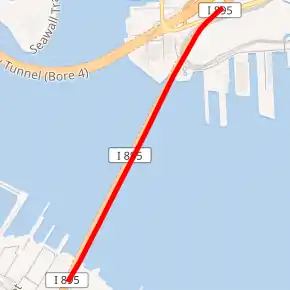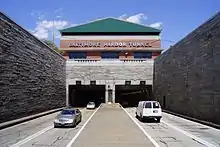Baltimore Harbor Tunnel
The Baltimore Harbor Tunnel is a pair of two-lane road tunnels carrying Interstate 895—the Harbor Tunnel Thruway—under the Patapsco River southeast of downtown Baltimore, Maryland, United States. The tunnel was designed by Peter Johnson.
_in_Baltimore_City%252C_Maryland.jpg.webp) Baltimore Harbor Tunnel, traveling northbound on I-895 | |
| Overview | |
|---|---|
| Location | Patapsco River, Baltimore, Maryland, USA |
| Coordinates | 39°15′15″N 76°34′16″W |
| Route | |
| Operation | |
| Opened | November 29, 1957[1] |
| Operator | MdTA |
| Toll | $4 (both directions) |
| Technical | |
| Length | 7,650 ft (1.45 mi; 2.33 km) |
| No. of lanes | 4 |
| Tunnel clearance | 14 ft (4.3 m) |
| Route map | |

| |
Description
The pair of tunnels is 7,650 feet (1.45 mi; 2.33 km) long, stretching from the south shore of the Patapsco River to the north shore near Dundalk. Each tunnel is 22 feet (6.7 m) wide and 14 feet (4.3 m) high, and accommodates two lanes in each direction. The maximum speed within the tunnel is 50 miles per hour (80 km/h). Two-way traffic may occur in either tunnel for overnight roadwork or during emergencies that close down one of the tunnels. During implementation of two-way traffic, drivers may experience 15-20 minute delays while two-way operations are being setup. When one lane of southbound and northbound traffic are directed into the tunnel that remains open are implemented. The MDTA uses traffic cones and barrels to act as a crossover before and after the tunnel. So traffic can safely crossover to the northbound or the southbound sides of the roadway after the tunnel. The Tunnel has lane control signals to control which lanes are open,closed or as contra-flow traffic.[2]
Both portals have ventilation buildings, with a total of 32 fans in place to replace the air within the tunnels, which is drawn in through the tunnel floors and exhausted through the tunnel ceilings. The tubes themselves range from a depth of 50 feet (15.2 m) below ground to 101 feet (30.8 m) below ground.

As of July 1, 2015, the toll rate for cars is $4.00 cash or $3.00 E-ZPass, paid in either direction. Vehicles with more than two axles pay additional amounts, up to $30.00 for six axles.[3] In March 2020, all-electronic tolling was implemented as a result of the COVID-19 pandemic, with tolls payable through E-ZPass or Video Tolling, which uses automatic license plate recognition. All-electronic tolling was made permanent in August 2020.[4]
History
The tunnel and approaches were designed by Singstad and Baillie, a New York-based engineering firm specializing in tunnel design, in association with the J. E. Greiner Company, a local Baltimore-based firm. The tunnel was formed out of twenty-one 310-foot-long (94 m) sections individually submerged into the harbor and secured with rocks and backfill; the first of these tunnel segments was sunk on April 11, 1956.[5] The remainder of the tunnel was constructed using the cut-and-cover method, extending from the submerged tubes to the north and south portals. The project's costs would ultimately reach $150 million ($1,365 million in 2019).[6]
The tunnel opened on November 29, 1957 with a dedication by Maryland Governor Theodore McKeldin and a crowd of 4,000 spectators.[7] The initial toll for standard cars was forty cents.[1] In the first 12 hours of operation, the tunnel handled an estimated 10,000 vehicles, mostly drivers from Maryland.[8] In the same period, the tunnel also experienced its first collision (15 minutes after opening), first flat tire and first stalled vehicle.[9]
The tunnel was considered a success by the Maryland Transportation Authority (MDTA), as it eliminated 51 traffic signals for through-traffic in Baltimore, and reduced neighborhood street commercial traffic by up to 40%.[10] However, increased tunnel usage and high traffic volume led to the planning, construction, and opening of the nearby Fort McHenry Tunnel in 1985, creating the final link of Interstate 95 in Maryland. The Harbor Tunnel was then closed in phases for extensive rehabilitation, beginning in March 1987.[11] It was fully reopened by 1990.

_at_the_north_entrance_to_the_Baltimore_Harbor_Tunnel_in_Baltimore_City%252C_Maryland.jpg.webp)
In November 2007, the 50th anniversary of the tunnel serving travelers was observed.[12][13] In November 2018, the MDTA started a multi-year project to replace the I-895 bridge spans north of the tunnel. The $189m project also includes $28m to repair and upgrade the tunnel itself; the entire project is scheduled to be completed by summer 2021.[14]
See also
 Maryland Roads portal
Maryland Roads portal
References
- "Baltimore Opens Harbor Tunnel". The News and Courier. Charleston, South Carolina. November 29, 1957. p. 2-A – via Google News Archive.
- https://mdta.maryland.gov/blog-category/mdta-traffic-advisories/i-895-baltimore-harbor-tunnel-overnight-lane-closures-week-35
- "MdTA toll rates: Baltimore Harbor Tunnel, Fort McHenry Tunnel and Francis Scott Key Bridge". Retrieved July 26, 2016.
- "All-Electronic Tolling Now Permanent at All MDTA Facilities Statewide in Maryland". Salisbury, MD: WBOC-TV. August 6, 2020. Retrieved August 6, 2020.
- "1st Tunnel Unit Lowered Into Harbor". The Evening Sun. Baltimore, Maryland. April 11, 1956. p. 80. Retrieved February 29, 2020.
- Hirzel, Donald (November 28, 1957). "Dedication of Harbor Tunnel Tomorrow Caps 36-Year Battle". The Evening Sun. Baltimore, Maryland. p. 45. Retrieved February 29, 2020.
- Trewhitt, Henry L. (November 30, 1957). "$144,000,000 Harbor Tunnel Is Opened By Governor McKeldin". The Baltimore Sun. Baltimore, Maryland. p. 26. Retrieved February 29, 2020.
- Hirzel, Donald (November 30, 1957). "10,000 Vehicles Use Harbor Tunnel In First 12 Hours After Opening". The Evening Sun. Baltimore, Maryland. p. 18. Retrieved February 29, 2020.
- Holcomb, Charles (November 30, 1957). "Initial Crash - Tunnel Has 'Firsts'". The Evening Sun. Baltimore, Maryland. p. 18. Retrieved February 29, 2020.
- Maryland Transportation Authority. "The Baltimore Harbor Tunnel" (PDF).
- McCord, Joel (March 11, 1987). "Harbor Tunnel work to force rerouting of northbound traffic". The Baltimore Sun. Baltimore, Maryland. p. 18. Retrieved February 29, 2020.
- "Baltimore Harbor Tunnel is 50". TOLLROADSnews. November 29, 2007. Archived from the original on February 19, 2009. Retrieved December 26, 2007.
- "Harbor Tunnel marks 50th anniversary". Baltimore Sun. November 21, 2007. Retrieved November 21, 2007.
- "Project Timeline". MDTA website. Retrieved July 15, 2020.
External links
![]() Media related to Baltimore Harbor Tunnel at Wikimedia Commons
Media related to Baltimore Harbor Tunnel at Wikimedia Commons